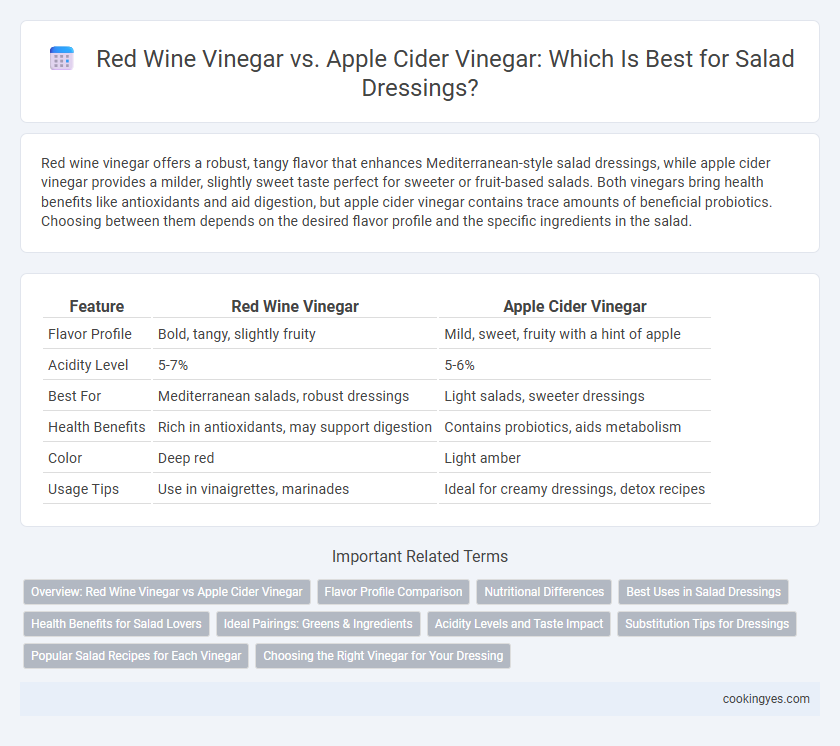Red wine vinegar offers a robust, tangy flavor that enhances Mediterranean-style salad dressings, while apple cider vinegar provides a milder, slightly sweet taste perfect for sweeter or fruit-based salads. Both vinegars bring health benefits like antioxidants and aid digestion, but apple cider vinegar contains trace amounts of beneficial probiotics. Choosing between them depends on the desired flavor profile and the specific ingredients in the salad.
Table of Comparison
| Feature | Red Wine Vinegar | Apple Cider Vinegar |
|---|---|---|
| Flavor Profile | Bold, tangy, slightly fruity | Mild, sweet, fruity with a hint of apple |
| Acidity Level | 5-7% | 5-6% |
| Best For | Mediterranean salads, robust dressings | Light salads, sweeter dressings |
| Health Benefits | Rich in antioxidants, may support digestion | Contains probiotics, aids metabolism |
| Color | Deep red | Light amber |
| Usage Tips | Use in vinaigrettes, marinades | Ideal for creamy dressings, detox recipes |
Overview: Red Wine Vinegar vs Apple Cider Vinegar
Red wine vinegar and apple cider vinegar both offer unique flavors and health benefits for salad dressings, with red wine vinegar providing a robust, tangy taste rich in antioxidants, while apple cider vinegar contributes a milder, slightly sweet profile known for its potential digestive and blood sugar regulation properties. Red wine vinegar is derived from fermented red wine grapes, enhancing salads with bold acidity and complex fruity notes, whereas apple cider vinegar is made from fermented apple juice, imparting a subtle tartness and beneficial probiotics. Choosing between them depends on the desired flavor intensity and health goals, with both vinegars effectively enhancing the nutritional value and taste complexity of salad dressings.
Flavor Profile Comparison
Red wine vinegar offers a robust, tangy flavor with subtle fruity undertones, enhancing savory salad dressings with depth and complexity. Apple cider vinegar provides a milder, slightly sweet and crisp taste, lending a bright, refreshing note that complements fresh greens and sweeter ingredients. Choosing between these vinegars depends on desired flavor intensity and salad composition, with red wine vinegar suiting hearty salads and apple cider vinegar ideal for lighter, fruitier combinations.
Nutritional Differences
Red wine vinegar contains fewer calories and sugars compared to apple cider vinegar, making it a lower-calorie choice for salad dressings. Apple cider vinegar offers higher levels of acetic acid and beneficial probiotics, which may aid digestion and support gut health. Both vinegars provide antioxidants, but apple cider vinegar typically contains trace amounts of potassium and other minerals, enhancing its nutritional profile.
Best Uses in Salad Dressings
Red wine vinegar offers a bold, tangy flavor that enhances Mediterranean and Greek salads, pairing well with olive oil, herbs, and feta cheese. Apple cider vinegar provides a milder, slightly sweet taste ideal for fruit-based or autumnal salads featuring ingredients like apples, nuts, and mixed greens. Both vinegars balance acidity and brightness, but red wine vinegar works best for robust, savory dressings while apple cider vinegar complements lighter, sweeter salad profiles.
Health Benefits for Salad Lovers
Red wine vinegar contains antioxidants like resveratrol that support heart health and reduce inflammation, making it beneficial for salad lovers seeking nutrient-dense dressings. Apple cider vinegar is rich in acetic acid, which aids digestion, regulates blood sugar levels, and promotes gut health through its probiotic properties. Both vinegars enhance flavor while offering distinct health benefits, with red wine vinegar favoring cardiovascular support and apple cider vinegar optimizing digestive wellness.
Ideal Pairings: Greens & Ingredients
Red wine vinegar pairs exceptionally well with robust greens like arugula, spinach, and mixed field greens, enhancing their peppery and earthy flavors. Apple cider vinegar complements milder greens such as butter lettuce, kale, and romaine, adding a subtle fruity tang that balances creamy ingredients like avocado and feta. Both vinegars integrate seamlessly with ingredients like cherry tomatoes, cucumbers, and herbs, but choosing between them depends on whether the dressing aims for bold or delicate flavor profiles.
Acidity Levels and Taste Impact
Red wine vinegar typically has an acidity level around 5-7%, providing a robust and slightly fruity flavor that enhances bold salad dressings. Apple cider vinegar has a similar acidity level of about 5-6%, but its taste is milder and fruitier with subtle sweetness, making it ideal for light, fresh dressings. Choosing between these vinegars depends on desired taste impact; red wine vinegar adds sharpness and depth, while apple cider vinegar offers a softer, tangy profile.
Substitution Tips for Dressings
Red wine vinegar offers a robust, tangy flavor that complements Mediterranean-style dressings, while apple cider vinegar provides a milder, fruity acidity ideal for sweeter or more delicate salads. To substitute red wine vinegar with apple cider vinegar, reduce the quantity slightly to avoid overpowering the dressing's balance and consider adding a pinch of sugar or honey to replicate the richness. For best results, adjust seasoning gradually and taste frequently to maintain the desired harmony of flavors in your salad dressing.
Popular Salad Recipes for Each Vinegar
Red wine vinegar is a classic choice for Mediterranean and Greek salads, enhancing flavors in recipes with olives, feta cheese, and tomatoes. Apple cider vinegar pairs well with sweet and tangy dressings, often used in spinach salads with apples, walnuts, and goat cheese. Both vinegars add distinct acidity that complements specific ingredients, making them staples in popular salad recipes worldwide.
Choosing the Right Vinegar for Your Dressing
Red wine vinegar offers a robust, tangy flavor with fruity and spicy undertones perfect for Mediterranean salads, while apple cider vinegar provides a milder, slightly sweet taste with a hint of apple, ideal for lighter dressings and health-focused recipes. Selecting the right vinegar depends on the flavor profile you want to enhance; red wine vinegar complements bold ingredients like olives and herbs, whereas apple cider vinegar pairs well with fresh greens and sweeter components like fruit or honey. Adjust vinegar quantity based on acidity preference to achieve a balanced dressing that elevates the overall salad experience.
Red wine vinegar vs Apple cider vinegar for dressings Infographic

 cookingyes.com
cookingyes.com